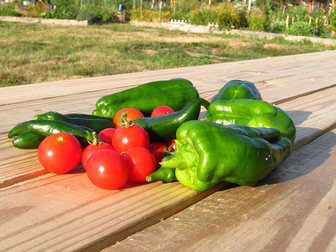
The rules for when to harvest depend on what vegetables you’re growing. For leaves, stems and some root crops, you want to pick `em early – while they’re still at their most tender state. Ever eat woody asparagus? It’s ripe, but it’s so much tastier when picked while it’s young.
For vegetables where the “fruit” or “seed-bearing” part of the plant is what you’re eating — tomatoes or peppers — the opposite is true. A tomato may be ready, even red, but it tastes a lot better when it’s picked as ripe as possible and eaten straight from the vine.
Of course, there are always exceptions to the rule. Many vegetables can taste better while still young. For example, the French love their baby peas or a small zucchini generally has more flavor and is more tender than one that’s been allowed to grow into a giant.
A lot of when to harvest is just common sense. Herbs usually taste better before they’ve gone to seed. Pick corn when it’s sweeter rather than waiting for it to get old and starchy.
Other veggies can wait it out until you’ve got the time. Root crops, like carrots, onions and potatoes, generally have a larger window of picking opportunity than other vegetables.
The best time to harvest is in the morning, right after the dew has dissipated. That’s when your vegetables will have the highest water content. It’s also good to pick vegetables during cloudy days or when you’re going through a cool spell for the same reason. (If you’re growing grains, though, you’ll want to harvest when dry.)
Before your vegetables are ripe for the picking, round up all the tools that you will need to harvest them. Also, come up with a picking strategy: where will you put all your produce? Is it all going to ripen at once or can you harvest early and often? Do you need a ladder or other special tools to reach or harvest? Finally, you’ll want to know where to store, and how to store, what you’ve picked.
Steps for Superior Vegetable Storage
Different garden vegetables require different storage conditions. What’s best? Here are some suggestions to help you get started:
Counter Storage. Some vegetables do best just sitting on top of the kitchen counter where they can rest and ripen. These include tomatoes and peppers as well as fruits, such as peaches and plums.
Root Cellar. Everybody’s heard of root cellars, right? So it’s no surprise that a cool, dark cellar or basement can be a great place to store cabbage, carrots, beets, potatoes and other root vegetables. Don’t have a root cellar? Some gardeners prefer to store vegetables in the garden. When the ground begins to freeze, root crops can be covered with straw, hay, wood shavings or leaf mulch for protection.
The Refrigerator. Using cold for storing home garden vegetables such as lettuce, peas, corn, broccoli, cauliflower, herbs, or summer squash slows down their metabolism and preserves them. Use ventilated bags and insert a slightly moistened towel to keep herbs and lettuces moist, but not soggy.
Freezing. Locks in flavor and nutrients by quickly freezing fresh vegetables. Most fruits and vegetables do best if you blanch them in boiling water before freezing.
Canning. Canning is an easy way to preserve highly acidic vegetables such as tomatoes. You can also preserve in brine (think pickles) or in syrup (fruit preserves, sweetened relishes or chutneys).
Drying. Drying can be a great and easy way to preserve herbs. With a little more work and the help of a food dehydrator, you can dry many fruits and vegetables.
To store vegetables successfully, the following environmental conditions must be considered:Temperature. Cool temperatures (32 to 55°F) help to prevent moisture loss and delays the growth of bacteria and fungi that cause crops to spoil.
Moisture. Stored vegetables quickly shrivel and lose quality without proper moisture. Storage areas must have the humidity raised to reach the ideal 80 to 90 percent relative humidity that most vegetables prefer. A simple humidity gauge, available at most hardware stores, is the best way to measure the relative humidity.
Tip: The most effective way to control moisture loss is to place vegetables in polyethylene bags. Make several 1/4 to 1/3 inch holes in the sides of the bags and liners to allow proper ventilation.
Ventilation. Harvested vegetables “breathe” and require oxygen to maintain their high quality. Wilting and tissue breakdown are minimized by proper air circulation.

 RSS Feed
RSS Feed
